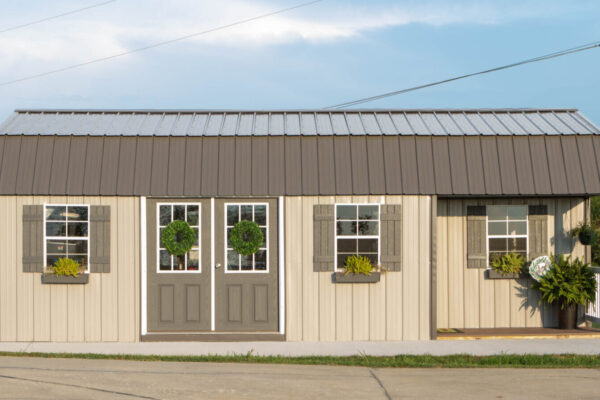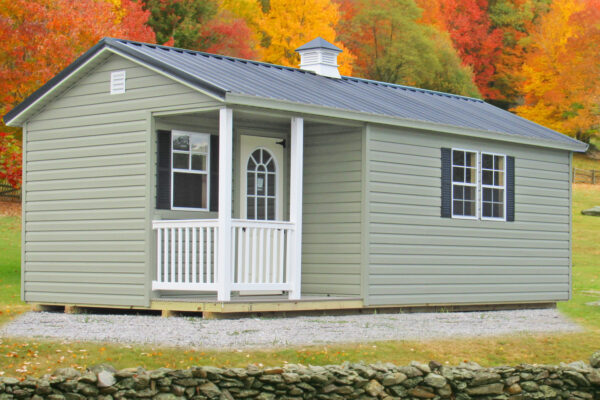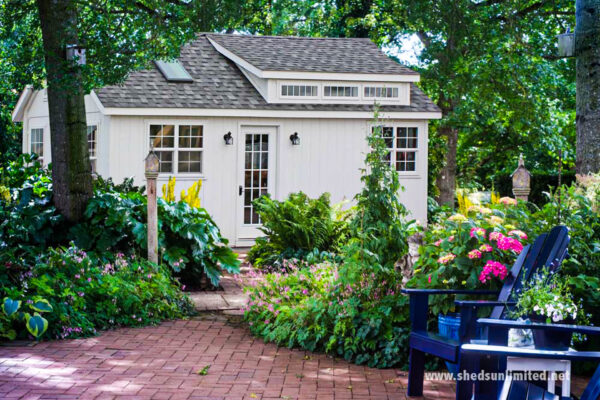Want more information on garden sheds? You’re in the right place. We’ve outlined siding and flooring options, prices, garden shed styles, ideas, and many FAQs within this article. Or, maybe you’re thinking about a shed greenhouse? Again, you’ve found the right article!
The shed at the back of the garden is more than just a place filled with tools and riddled with spiders. It is a symbol, a domestic oasis with an infinite number of possibilities and brimming with potential. It can be a source of personal refuge in the form of an office, a lawnmower shed, a playroom, or the place that houses your most prized power tools. Enough with the poetics! Let’s further our education!
Contents
What Is A Garden Shed?
A garden shed is typically a single-story indoor closure commonly found in the corner of your backyard. Sheds vary in size, style, material, construction, and function to meet differing needs. Each variation has its own unique properties and pros and cons, which can sometimes be hard to navigate. However, with the popularity of garden sheds increasing, an abundance of helpful advice will turn the plethora of choices out there into an advantage.
Though outdoor storage sheds have been typically used just for housing your lesser-used items and garden tools in the past, garden sheds today are also being used for separate working spaces or peaceful escapes. They can become a defining element in your garden rather than being hidden away in a far corner and can add interest and intrigue to your property.
Benefits Of A Garden Shed
There are numerous advantages to owning a garden shed. Maintaining a beautiful and well-trimmed garden takes patience, skill, and tools. While you can toss these tools to the corner of your garden, a garden shed will keep them protected, and best utilize your space. Speaking of the outdoors and benefits, we have another article on the benefits of backyard chickens.
The benefit of a garden shed just used for storage is immense and helpful in many ways. Check out more benefits through our table below!
| Advantage | Why does this matter? |
| Organized Gardening Tools | Your gardening tools no longer need to be lying around on the ground. Instead, they can hang on hooks, sit on shelves, and be organized in whatever way you please. |
| Quicker Access to Needed Tools | Having everything displayed in front of you is more efficient than a pile on the ground or needing to retrieve your tools for your garden from the garage. |
| Improve Garden Aesthetics | Decorating your garden shed with flowers and painting it a beautiful color can add interest and intrigue to your space. |
| Free Up Space | For example, you may be placing your tools in the garden, the garage, or on the porch. In addition, introducing a place to store all these items will free up space for other activities. |
| Increases Property Value | An extra structure in the garden will give your house the edge over other properties in the area. |
Garden Shed Ideas and Uses
Wondering how you can transform your garden shed? Needing some inspiration? You’ve come to the right place. There are many different functions a garden shed can have, including the following:
- Garden Storage
- Workshop Shed
- Potting Shed
- Kid’s Playhouse
- Art Studio
- Library/Reading Room
- Bar or Pool House
- Game or Entertainment Room
- Gym
- Home Spa
- Home Office
1. Garden Storage
The most obvious use is a garden shed to store your garden supplies and tools. They will be kept protected from the elements and ready for immediate use.
2. Workshop Shed
Your shed can be used for your DIY projects. Your shed can house your machinery, tools, and materials, whether you are woodworking, lathing metal, or using it as an area to clean your tools. A dedicated shed comes without the worry of ruining a living space with your projects. Instead, you can build a sturdy working table into the plans of the construction of your shed and easily organize everything you need.
3. Potting Shed
A potting shed gives a great environment to your smaller plants and seeds. You can use your shed as a place to cultivate life and plan your garden for the seasons. It can be a perfect place to store several sizes of potting for your growing plants and store your garden’s harvests.
4. Kid’s Playhouse
Creating an outdoor space for your children to play can be great fun for the kids and also a way to keep them occupied as well. It encourages them to be outdoors and can be filled with toys, kids’ furniture, and books. To make it more fun, you can paint it bright colors, allow it to be a place where your children can draw on the walls, or use chalkboard paint to make it even more fun. If you would like to read more about playhouses, feel free to take a look at our outdoor playhouse comparison guide.
5. Art Studio
You can turn your garden shed into a space where you either showcase your art, spend all day painting, drawing, and sculpting, or simply a place to store your artwork.
6. Library Or Reading Room
Turning your garden shed into a library or reading room is also a great idea. Away from the noise of the main living space, you can find peace in your garden space. It is also a great space to store books that you may not have room for and want to keep. You can easily decorate your shed with comfy furniture and add cushions and blankets to make it the perfect reading space.
7. Bar Or Pool House
Your shed can easily be turned into a bar during warmer months. Stock your shelves with your favorite drinks and add garden furniture to enjoy the sun while sipping away. Additionally, your shed can serve as a pool house, also storing pool accessories and acting as an easy relaxation place during pool parties.
8. Game Or Entertainment Room
A shed can be a perfect entertainment room. All you need is a screen and gaming console, sofas or comfy bean bags, a mini-fridge, and a sound system. It can be the perfect place for movie nights or bingeing your favorite TV series. But, of course, your children will also love entertaining their friends.
9. Gym
Turning your shed into a home gym can take minimal effort. Your own gym gives you the privacy and peace you need to get into that workout zone and also feel comfortable working out. You can use it as a yoga studio or buy the more expensive gym machines. It wholly depends on your needs.
10. Home Spa
There is nothing more luxurious or relaxing than having a home spa. Add a hot tub, candles, and incense, and you have the perfect spot to unwind alone or with company.
11. Home Office
A home office in your garden could give you the peace and quiet needed to motivate you to be the most creative and productive that you can be. The space can be decorated however you like, and a light-filled shed can lift your spirits and fight the procrastination and distractions your home may usually give you. If you would like to read more about shed ideas and uses, take a look at our “22 Inventive and Creative Shed Ideas & Uses” article.
Garden Shed Types
There are a number of different garden shed and shed greenhouse types to suit your needs. View our table to receive an overview.
| Garden Shed Type | Description | Pros | Cons |
| Basic | Flat-packed kits which require assembly and are made of either plastic, wood, or metal. | Easy assembly; low delivery cost | Require basic DIY knowledge; takes time to build If you lack confidence, have someone else build it for you. |
| Pre-Built | Requiring the least hassle and effort, already-built storage sheds are consistent in quality | Immediate use is possible; no need to build | Few companies offer; transportation can be high; need an easily accessible place for the shed |
| DIY | From start to finish, you can build out this shed as you desire. Nothing is off-limits. | Offers complete control of the project; can be cheaper; can blend with the existing structures and buildings on your property | Takes a lot of effort; need tools; takes skills such as wiring and water connection |
What Type Of Garden Shed Is Best?
The type of garden shed best for you depends on your budget and needs. Each type has its pros and cons that may depend on what you will use your shed for. With plenty of choices out there, pre-built options or DIY will definitely give you the most versatility. We also have a 3D design tool to help build your own personalized perfect shed on their website.
Garden Shed Styles
Ranch
The Ranch style is one of the more popular style choices when it comes to garden sheds. Its A-frame structure is a classic look that will look good in any space.
[products_multi_attributes attributes=”style” values=”ranch” per_page=”4″]
High Barn
High barn sheds are perfect for those who need to store as much as possible. Lofts are a standard feature of sheds of this type and offer two levels of storage at the same square footage of other shed styles. It is also a highly customizable style, with the entry being able to be built on the middle or sides, and the exterior can be any color or material.
[products_multi_attributes attributes=”style” values=”high-barn” per_page=”4″]
Low Barn
The Low Barn style is suitable for those who need the extra garden storage but are shopping on a budget. This is a simple style similar to the high barn but doesn’t boast the option of a second level. Featured below, the low barn is an affordable style that will cover your basic garden storage needs and can be customizable in the same way the high barn variation can be.
[products_multi_attributes attributes=”style” values=”low-barn” per_page=”4″]
If you would like to see more of our in-stock sheds, view our inventory page to browse our full selection of sheds and more!
Saltbox
This is a classic design derived from New England-style homes. These sheds have a lower back wall than the front to accommodate their roof style. This means there is lower headroom in the back of the shed than the front but offers an interesting shape to add to your backyard. This style also commonly includes double doors to fit your bigger items easily.
Modern Garden Sheds
Modern garden sheds offer the ability to showcase a unique and unusual structural shape in your outdoor space. These designs often offer glass as part of the design. Modern sheds commonly have glass double doors and transom windows above the door to let in sunlight. This style of shed is popular among those who turn their storage sheds into offices or living spaces.
Garden Shed Siding Options
Just like with garden shed styles, there are many choices when it comes to shed siding options: plastic, wood, engineered wood, and metal. Want to know some of the pros and cons of each garden shed siding option? Keep reading…
| Type: | Advantages: | Disadvantages: |
| Plastic/Resin/Vinyl Sheds | Durable; easy to assemble; rot and rust-free; easy to maintain | Limited styles and shapes; difficult customization process; non-eco friendly; flimsy and unbreathable |
| Wood | Easy customization and personalization; various sizes and accessories; painted/decorated exterior; easy assembly; efficient repair; good insulation | Necessary treatment of wood; less security; same amount of maintenance as a house |
| Engineered Wood | Same as wood; provides superior protection against the elements; smoother and cleaner; added strength; protection from termites, humidity, ect | Same as wood; more expensive |
Garden Roof Options
There are also many roof options available for your outdoor garden shed or shed greenhouse: metal, shingle, or cedar shakes.
- Metal: Metal roofing is a good option because it looks nice, is durable, and can easily be matched to metal siding. They commonly come in corrugated and standing seam styles.
- Shingle: Shingle roofing can provide your shed with extra longevity and add a textured and elegant appearance to your shed roof. They come in 3-tab and architectural styles.
- Cedar Shakes: Cedar shakes are similar to shingles but give your shed roof more of a rustic look. Both shakes and shingles are known for their natural resistance to the elements, their insulation quality, and their stability.
Popular Garden Shed Sizes and Prices
The purpose of your shed will be essential when considering what size to choose. Think about what you’ll be using your shed for and the size of the items that will need to fit inside. Be careful not to underestimate how much space you need; interior space disappears quickly.
How Are Garden Sheds Measured?
Sheds are measured along the exterior sides and so you will have less usable indoor floor space than the measurements suggest.
Garden Shed Sizes, Prices, and Shapes
| Standard Sheds Sizes | Price* |
| 8×10 | $2,500-$7,500 |
| 10×10 | $3,000-$8,000 |
| 10×12 | $3,500-$8,000 |
| 10×16 | $4,300-$8,000 |
| 12×12 | $4,400-$7,500 |
| 12×16 | $5,000-$8,000 |
| 12×20 | $5,300-$8,300 |
*Please keep in mind that all prices are rough estimates. Depending on siding, style, and customizations, prices may vary dramatically. While these prices reflect pre-built garden sheds, DIY garden sheds are generally less expensive.
There are also different shapes of sheds depending on the space you have available. Corner sheds are made to fit corners of gardens and are generally as small as a 3×3. Or, if you have space limitations but want more interior room, consider the addition of a dormer.
Is it cheaper to build a garden shed or buy one?
Overall, if you look purely at the numbers, it is cheaper to build your own garden shed instead of buying one from a company. However, there are a few things to consider when thinking about the overall price:
- Time. We all know that time equals money. And if it takes you an exorbitant amount of time to buy the materials, research how to craft a shed, and then build your garden shed, was it worth the saved money? Or did you save any money at all?
- Skill Level. Be honest with yourself. Do you have the skill level needed for a project that is this extensive? If not, get the pros involved! They will build a shed greenhouse or garden shed that will be both durable and made from quality materials. Don’t waste time and money on a project that will leave you frustrated and disenchanted.
- Warranty. Most shed companies offer a warranty on their sheds. At Esh’s Utility Buildings, we offer a 10 year warranty on all of our garden sheds and shed greenhouses. In the long run, this ensures that you have a quality product for a decade. Someone said money savings?!
Planning For Your Garden Shed
Planning for your garden shed is a critical process which includes planning the layout, designing the garden shed, and preparing the ground.
1. Planning Your Garden Shed Layout
To figure out the optimal size of your shed, you can lay out a footprint of the perimeter using garden stakes. Then, arrange the items you’d like to fit inside the area, adjust the stakes to the desired size, and measure the area. It is recommended to give yourself more space than you think you will need and accommodate enough room for a door to easily open and close.
When planning your shed, it is also vital to research town limits, zoning, utility lines and make sure it will be placed out of the way of any future need for system maintenance access.
2. Designing Your Garden Shed With A 3D Design Tool
3D design tools are a great way to play around with different options. We allow you to experiment and customize your shed on our 3D Designer by giving you a visual of your shed and enabling you to view how different materials, styles, and colors look. There are many possible color combinations that you can easily test with this feature.
3. How To Prepare The Ground For A Garden Shed
Your shed will sit best on a solid and level surface that won’t shift with the weather or move under the structure’s weight.
A patio or deck can serve as a base for lighter sheds, but a reinforced concrete slab or concrete piers are recommended for larger sheds. Ground anchors aren’t usually needed on these surfaces, but the concrete slab must be frost protected in cold climates, and piers must sit below the frost line to avoid shifting and tilting.
Arrowhead-style anchors are also a sturdy choice. They are driven into the ground and are secured with a rod, and can resist a large amount of tension. Sheds sitting on crushed stone or bark instead of a flat surface can topple in extreme wind or floods and need these types of anchors at each corner.
Garden Shed Permits And Planning Permission
It is best to consult your local area’s limits and regulations while planning your shed. In addition, you may need permits and permission depending on the size and location of your shed.
Is Planning Permission Required For A Garden Shed?
Building separate structures in addition to your main home usually requires planning permission. Check with your local authority, and they will be able to give you the best advice and information on what to do next. Constructing an outbuilding often has a legal requirement to obtain a permit. It can generally be granted if it is for housing or ancillary buildings, including sheds if the floor area is less than about 100 square feet. For information on shed permits in Tennessee, read our comprehensive article.
What Is The Biggest Garden Shed You Can Have Without Planning Permission?
You may not need planning permission in your area if your shed is 100 square feet or less or if your material is pre-fabricated. If the shed exceeds this size, it is likely you will need to apply for planning permission. However, it is always best to check local rules and regulations. Do not take these measurements as hard facts; these guidelines vary extensively based on your location.
Hobby Greenhouses
When we speak about garden shed ideas, one brilliant ways to use a garden shed is to convert it into a shed greenhouse! Dying to learn more? You’ve found the right place. Keep reading through some of the most frequently asked questions about hobby greenhouses:
Can I use a shed as a greenhouse?
Yes. It may be difficult to convert your existing shed into a well-insulated area with many window panels, sky lights, and an overhanging pergola. Difficult, but not impossible. However, at Esh’s Utility Building, we design sheds specifically for the purpose of being a greenhouse. Window panels, sky lights, and and overhanging pergola? Check, check, check. Each hobby greenhouse essentially becomes a shed nursery for your plant babies.
[products_multi_attributes attributes=”style” values=”greenhouse” per_page=”4″]
Is a potting shed as good as a greenhouse?
This is almost a trick question, because the purpose of both are very different. A potting shed is ultimately for the benefit of gardeners – it offers a protected space for planting flowers or other plants and storing gardening materials. However, it isn’t the ideal location for plants to thrive.
On the other hand, greenhouses are covered with windows, providing year-round growth. A shed greenhouse provides the most ideal spot for plants to grow due to optimal sunlight, temperature, and humidity. In contrast to potting sheds, greenhouses are often built with vents, vans, and shading systems in order to regulate temperature.
Bottom line: if you want a place for plants to grow and thrive year-round, invest in a greenhouse shed, not a potting shed.
Are home greenhouses worth it?
Yes! Shed greenhouses provide many advantages to your property, even increasing the overall worth of your home. For as little as $6,000, you can receive a shed greenhouse which will allow you to still enjoy the original intent of your property. The pros of shed greenhouses include:
- Climate control
- Protection from external elements
- Year-round growing
- Space efficiency
- Educational capabilities
- Wonderful aesthetics
- Multi-purpose use
While we strongly recommend shed greenhouses on your home property, there are several things to keep in mind. Depending on the height and design of a shed greenhouse, you may encounter one or more of the following disadvantages:
- Less sun exposure when compared to traditional greenhouses
- Less space compared to traditional greenhouse
- Limited height for taller plants
What is the best size for a hobby greenhouse?
Hobby greenhouses can range in size from 8×10 to 12×20 square feet. Of course, there are many factors to consider when deciding which size is the best option for your hobby greenhouse. If you have limited space and budget (and maybe less plants to grow), then a 8×12 square foot greenhouse will do the trick! However, if you’re looking for more space to store items and grow a wide variety of plants, we suggest you opt for the larger 12×20 square foot greenhouse. Go big or go home, right?
How do you ventilate a hobby greenhouse?
Don’t let ventilation concerns hinder your dreams for a hobby greenhouse! Read through these four easy solutions to ventilation for your hobby greenhouse.
- Exhaust fans make the overall temperature drop in your hobby greenhouse. For optimal results, place the exhaust fan on the top of the roof.
- Roof vents allow for more airflow within your hobby greenhouse, helping to prevent your beloved plants from wilting and dying.
- Open panes on the walls and ceiling of your shed greenhouse welcome fresh billows of air.
Greenhouse Shed Ideas
A greenhouse can become your therapy haven, giving you a location to dig your hands in the comfort of dirt. Want some other ideas?
- Educational spot: Teach your kids the importance of plants and empower them to plant their own through your hobby greenhouse.
- Extra storage: Keep everything in one place. From your garden gloves to seeds to potted plants, everything will be able to have a place. But at the same time, you’ll be right by your favorite plant babies.
- Herb Haven: Like to cook? Fill your hobby greenhouse with herbs, from rosemary to mint. Now you’ll just be walking distance away from an ideal source of flavor for all of your dishes.
How warm does a shed greenhouse stay in winter?
If your shed greenhouse is well-insulated, the interior may be around 40-50 degrees Fahrenheit in the winter. However, this varies extensively depending on the region in which you live and the weather that you experience. If temperatures drop well below freezing, it may become extremely expensive to keep a GHAT system running throughout the winter months.
Are unheated shed greenhouses worth it?
Yes. It all boils down to expectations, though. Do you expect to keep vegetable and fruit plants alive in the dead of winter? If so, an unheated shed greenhouse is not worth it. But, if you would like to have a shed greenhouse which offers a jump-start location for growing plants in the spring, take advantage of this space efficient option! Additionally, shed greenhouses provide a good environment for annual plants to grow and blossom throughout the year.
How to build a greenhouse attached to a shed?
Do you have an old shed on your property that would be perfect for a greenhouse addition? Now is the perfect time to start building! Before you despair by the magnitude of the project, let’s dig into some easy steps:
- Check local building regulations.
- Using sturdy anchors or bolts, attach framing to the shed.
- Build the frame for the greenhouse.
- Provide access and ventilation by installing windows and doors.
- Add ventilation (think vents, windows, or fans).
- Seal any gaps to prevent heat loss.
Garden Shed FAQs
These are some of the most common questions asked concerning garden sheds.
Can I Live In A Shed In My Garden?
Depending on the area in which you reside, your city, state, and county zoning laws may differ from others, so it’s always important and encouraged to check. If you intend to live in your shed or use it for residential purposes for someone else, it is crucial to find out before you begin planning.
You will most likely need planning permission to build and connect utilities to your shed before turning it into a tiny home.
How Can I Supply Electricity To A Garden Shed?
Professional tradespeople can help you with any questions around permissions and inspection of your site for the potential to connect utilities. You will be most likely to get approved for service ranging between 50 and 100 amps. In comparison, a home is usually a 200 amp service. However, that allowance should be more than enough to power your smaller space.
It is best to add outlets and utilities while your interior is unfinished, as, at this stage, it is cheap to add these in. Make sure you have enough outlets at this point for power tools, or perhaps a mini-fridge or computer. It is safest to overestimate how many you will need.
How Can I Keep A Garden Shed Cool In Summer?
Keeping your garden shed cool during warmer months can be tricky, especially if you live in a region prone to soaring temperatures. The best type of shed to get you through warmer temperatures is wooden sheds, as they are well insulated.
Aside from fans and air conditioning, ventilation can be added to your roof. Wind ventilation and cross ventilation designs are used to keep a lower temperature within and allow heat to filter out. Cleverly positioning your doors and windows will drastically help with ventilation and keep air circulation strong. Glazed windows also slow down heating as they deflect the warmth of sunlight.
The position of your shed is also a key factor. For example, placing your shed in the shade of trees will drastically help cool it down as opposed to placing it in direct sunlight.
How Can I Secure My Garden Shed?
Garden sheds are a common target for thieves and vandals. Plus, your garden shed is not always in your sights and can be out of hearing range if a thief tries to break in. In addition, your shed may house valuable items and, without the proper precautions, can easily be taken without you knowing. Moreover, the tools stored in your garden shed can also be helpful to thieves trying to break into your house. Therefore, keeping your shed secure is essential even if you don’t see the contents as being particularly valuable.
You can do numerous things to keep your shed safe and secure from thieves and vandals.
- Choose the location carefully
- Anchor the shed
- Replace the door hinge
- Improve the lock
- Obscure windows
- Fit an Alarm
- Put tools away at night
- Mark your belongings and register your items
Your local authority will also have many tips on keeping your property secure from thieves.
How Can I Decorate My Garden Shed?
Your shed is a valuable addition to your backyard but can also become an eyesore. Your backyard shed needs to earn its place and look good while being functional. There are many ways to spruce up a garden shed, from painting, to adding furnishings, to upgrading the roofing after a few years or changing the function of your shed to keep it an exciting element in your garden.
You can do many things to make it your own and maximize its potential. Read through these garden shed ideas:
- Paint your shed
- Fix a water butt to your shed
- Use your shed to attract wildlife by adding a birdhouse
- Add a green roof to your shed where you can grow plants and help it seamlessly blend into the flora around it
- Use your shed as a focal point instead of trying to hide it away
- Build shelves in your shed and add hooks
- Screen your shed with plants or add lattices for growing ivy
- Add comforts such as garden chairs and tables to the exterior
The sky’s the limit in decorating and filling your new space.
Conclusion
When it comes to outdoor storage sheds, there are a plethora of options out there. Finding your perfect shed for your space, needs, and budget requires consideration and planning. There are many advantages and disadvantages to consider when choosing the shed that will benefit you the most. If you’re interested, you can also learn about the benefits of sheds with porches. If you think that perhaps a 12×24 storage building is best for you, you could start that journey by reading this article. To find your perfect garden shed, go check out our outdoor storage sheds, and with our 3D design tool, pre-built sheds, and expert advice, you will undoubtedly find the shed for you.
No matter what you decide, we wish you all the best on your new garden shed ventures!





